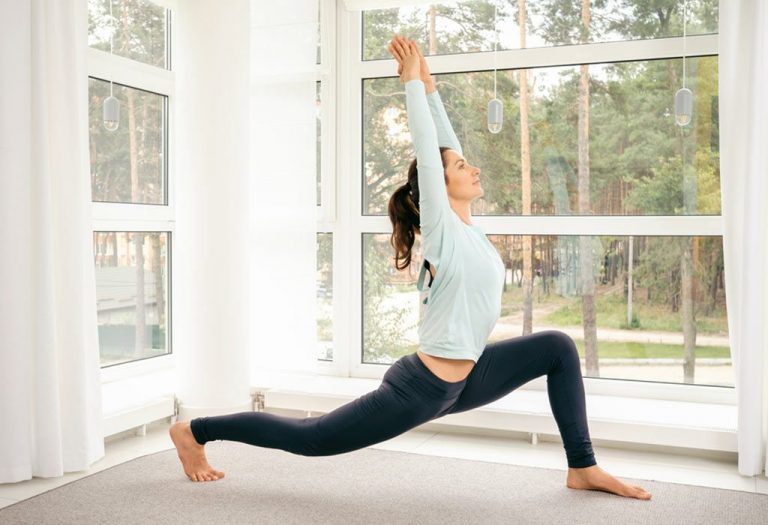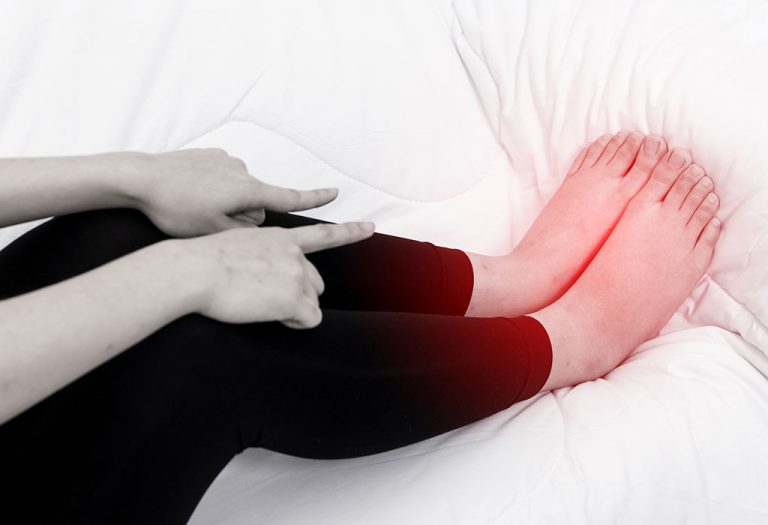Postpartum Yoga – Benefits, Poses and Precautions

- Benefits of Doing Yoga After Pregnancy
- Things You Will Need for Performing Yoga
- Precautions to Take While Doing Postnatal Yoga
- Post Pregnancy Yoga Poses for New Moms
- FAQs
Pregnancy may be one of the happiest phases in a woman’s life, but there is no denying that the stress and strains it puts a woman’s body through are immense. Most women struggle with common day-to-day activities after giving birth as the body is still recovering from the rigours of pregnancy and labour. Postnatal yoga is a gentle and effective way for new mothers to regain their physical and emotional well-being after childbirth. This practice focuses on gradually rebuilding strength, improving flexibility, and promoting relaxation, which is crucial during recovery.
Read on to learn more about the numerous benefits of yoga after delivery, specific poses that can aid in recovery, and important precautions to remember to ensure a safe and effective practice.
Benefits of Doing Yoga After Pregnancy
Here are a few benefits of yoga for postnatal recovery. These benefits can significantly aid in your journey to regain strength and wellness after childbirth.
- Postnatal recovery: A woman’s body undergoes tremendous changes during pregnancy. These changes cause a lot of stress to all parts of the body; plus, the process of carrying a baby and giving birth is painful. Yoga after a normal delivery is a great way to gradually soothe the strain the body has endured due to pregnancy (5).
- Weight Loss: All women put on weight during pregnancy. The added requirement of taking in more than usual nutrients and carrying the extra weight of the baby causes weight gain in pregnant women. The problem begins post-delivery when the extra weight is no longer required. Losing weight post-delivery is not easy. Yoga, however, is a tried and tested ancient regimen; some discipline and a little time per day to perform yoga can yield fantastic results for losing weight post-pregnancy (3).
- Endurance: Most new mothers experience weakness after pregnancy. Symptoms of this weakness include loss of stamina, muscle/joint pain, and chronic exhaustion. Yoga gently and slowly exercises the muscles and joints back to their original strength and gradually boosts core strength and stamina.
- Regaining Posture: Nine months of pregnancy followed by caring for the infant post-birth will inevitably throw a woman’s normal body posture out of sync. Moving around with a growing baby in the womb is stressful on the spine. Nursing and constantly lifting the little one after birth puts added stress on the neck and shoulders. Yoga strengthens all the essential muscles and joints and can even help women achieve better posture than pre-pregnancy.
- Psychological Benefits: Yoga focuses on deep breathing, stretching, and relaxing the body. The combination of movements and breathing improves blood circulation and oxygenates the body at the same time. As such, yoga can induce a state of deep relaxation, reducing stress and calming the body and mind (2).
Things You Will Need for Performing Yoga
While yoga is mostly a freehand form of keeping fit and comprises breathing and body movements, some basic equipment would be helpful to make exercise and fitness routines relatively comfortable. Below is a list of things that should be used for post-pregnancy yoga.
- A Rubber Mat: A soft rubber mat is a prerequisite for yoga. It provides cushioning between your body and a hard floor and a firm, non-slipping surface, preventing possible injuries.
- A Blanket: Certain poses require additional padding to prevent discomfort. Choose a medium-thick, soft blanket.
- Blocks: Blocks are helpful for advanced poses that require extreme flexibility; beginners can perform advanced manoeuvres with them.
- A Strap: Straps are useful support devices that help you stretch and support your limbs during difficult yoga poses.
- Sportswear: Proper gear and clothes are essential for any type of workout routine. Yoga involves a lot of stretching and complicated postures, so it is essential that the clothes worn during these sessions can stretch and move along with the body without getting in the way.

Precautions to Take While Doing Postnatal Yoga
When practising postnatal yoga, taking certain precautions is crucial to ensure a safe and effective experience. These measures help protect your body as it heals and adapts to post-pregnancy changes. Here are some key precautions to consider:
- Before starting any yoga routine, get clearance from your doctor to ensure it’s safe for your specific condition.
- Begin with gentle poses and gradually increase intensity as your strength and stamina improve.
- Pay attention to any discomfort or pain and modify or skip poses that don’t feel right.
- Avoid intense abdominal exercises initially and focus on rebuilding core strength gradually.
- Ensure you drink plenty of water and rest adequately to support your body’s recovery and overall well-being.
Post Pregnancy Yoga Poses for New Moms
Below are selections of postpartum yoga poses and manoeuvres that would be useful for women. The first few poses help with stretching, warm-up, and flexibility, followed by poses for more advanced benefits.
1. Neck Stretch (Roll)
This pose is great for stress relief but needs to be performed cautiously.
Benefits:
Imparts flexibility to the neck, eases muscle tension, provides a warm-up for more advanced poses.
How to Perform:
Sitting in a cross-legged position, inhale deeply. Slowly turn your head to the right until your muscles feel stretched. Take three deep breaths and slowly return to the normal position.
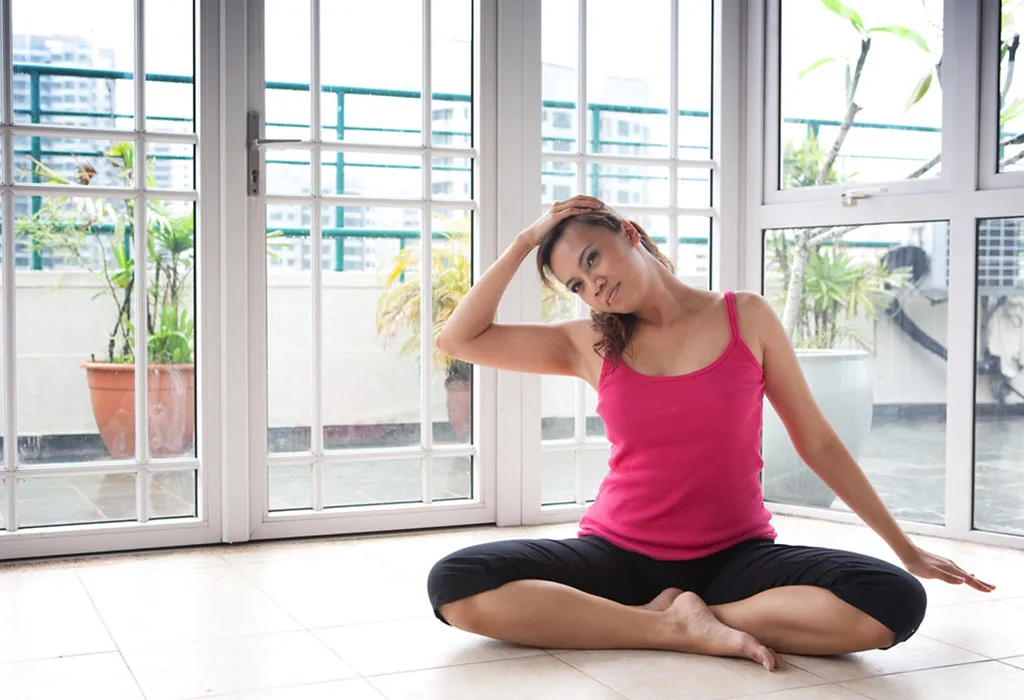
2. Shoulder Stretch (Roll)
This pose imparts flexibility to the shoulders.
Benefits:
Eases muscle tension, loosens shoulder muscles and provides a warm-up for more advanced poses.
How to Perform:
Sitting in a cross-legged position, keep your arms straight on the sides. Slowly move your shoulders forward and bring them towards your earlobes without moving your arms, essentially in one rotation. Continue rolling and move backwards and then downwards. This completes one rotation. Repeat the movement seven times, pause for five seconds, and then reverse the movement and perform seven repetitions.
3. Chest Stretch
This can be used as a warm-up pose after which high-level poses can be done.
Benefits:
Stretches, loosens, and relaxes chest and upper back muscles, and eases muscle tension in the thorax.
How to Perform:
Sit up straight in a cross-legged position. Keep your arms straight on the sides and your spine straight. Now close your eyes and inhale deeply, expanding your chest and abdomen muscles. Hold for five seconds and slowly exhale; pause for five seconds and inhale again, repeating the motion for at least twenty repetitions. Note that this exercise has to be performed slowly and stop immediately in case of discomfort, breathlessness or dizziness.
4. Feet Stretch
This pose is good for the lower part of the body.
Benefits:
Stretches the feet, exercises the calf muscles, and improves circulation.
How to Perform:
Get into position by resting both knees and hands on the mat. Slowly walk your hand backwards, lowering your back till your bum has touched the heels of the feet. Now rest the bum on the heels of your feet and straighten your back. You should be sitting straight with your hand on your thighs, and your bum will be resting on the heels of your feet; at this point, the soles of your feet should feel stretched. Hold the position for eight seconds before relaxing. Repeat this movement five times and try to increase the holding time.
5. Pelvic Tilt
This pose helps strengthen the core.
Benefits:
It exercises the muscles of the lower back, abdomen and buttocks.
How to Perform:
Lie down on the mat and fold your knees, keeping your feet on the mat and the palms of your hand alongside your hips, touching the mat. Maintain a neutral spine inhale while lifting your hips. Pause for three seconds and exhale slowly, bringing your hips back to the mat; rest for three seconds and repeat. Twenty repetitions per session of this movement should suffice.
6. Kegel Exercise
Kegel exercises strengthen the pelvic floor (1).
Benefits:
Pregnancy often results in a weakened pelvic floor which can result in a lessening of sexual pleasure and control on the urinary bladder.
How to Perform:
Lie down on your back, fold your knees with the soles of your feet touching the mat, and your hands on the navel. Contract the muscles of the lower abdomen—the muscles you would use to stop urinating mid-way—hold for five seconds. Release and inhale, pause for five seconds, and repeat. Practice twenty repetitions per session.
7. Pelvic Rocking
This position helps in the release of flatulence.
Benefits:
Pregnancy puts pressure on the abdomen resulting in weakened muscles. Pelvic rocking strengthens the abdominal muscles.
How to Perform:
Lie down with your knees folded and your hands on the sides. Exhale and move your navel upwards and inwards. Inhale and move your navel downwards, pause for three seconds and repeat. Do twenty repetitions per session.
8. Tiger Pose
This works on all the major muscles of the body.
Benefits:
It helps to relieve back pain and rejuvenates the reproductive organs.
How to Perform:
Get into position with both knees and palms resting on the mat. The knees should be in line with the thighs, and the palms should be in line with the shoulders. Now, lift your right knee and stretch out your right leg, bringing it in line with your hips and parallel to the floor. Raise your right leg, bend your knee, and get the heels of your feet towards your buttocks. At the same time, raise your shoulder and tilt your head backwards. Inhale during this movement and hold for four seconds; exhale and move your knees towards your chest and lower your shoulders. Move the head towards the chest, trying to touch your head to your knee, and hold for four seconds. Pause for four seconds and repeat with the left leg. Perform this movement for five repetitions.
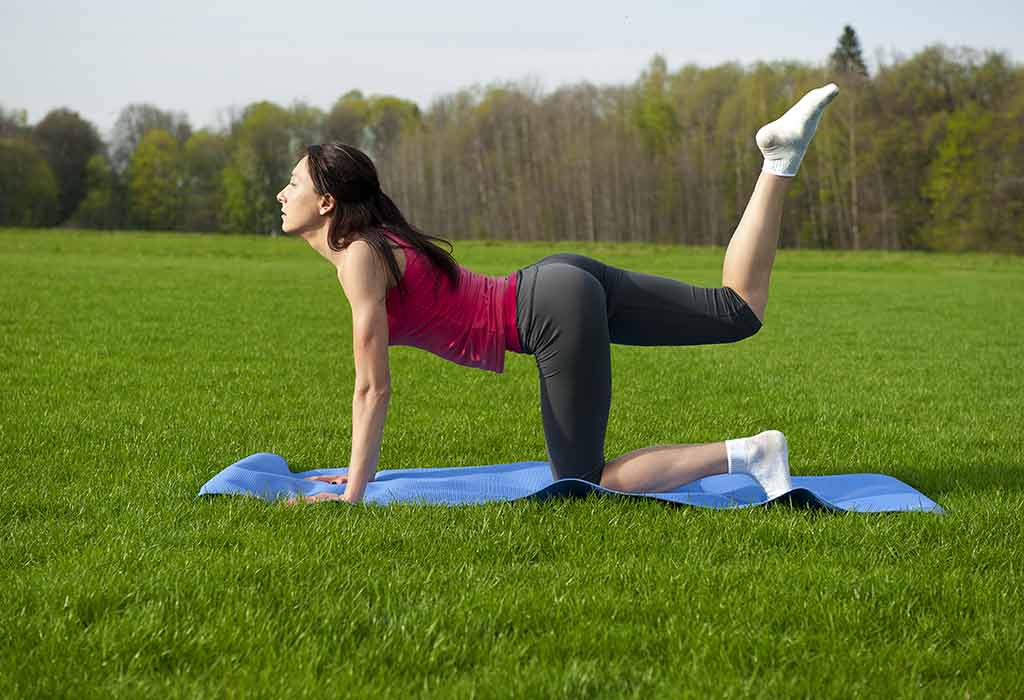
9. Cobra Pose
The Cobra pose helps to tackle back pain problems after delivery.
Benefits:
Strengthens the arms, shoulders, spinal column and buttocks.
How to Perform :
Lie down on your tummy, keeping your whole body straight and your feet together. Bring your arms below your shoulders, inhale, and gently lift your upper body while keeping your waist firmly on the mat. Lift as much as possible without hurting yourself, hold this position for ten seconds, then exhale and return to lying down and relaxing. Repeat this manoeuvre ten times, twenty times if possible.
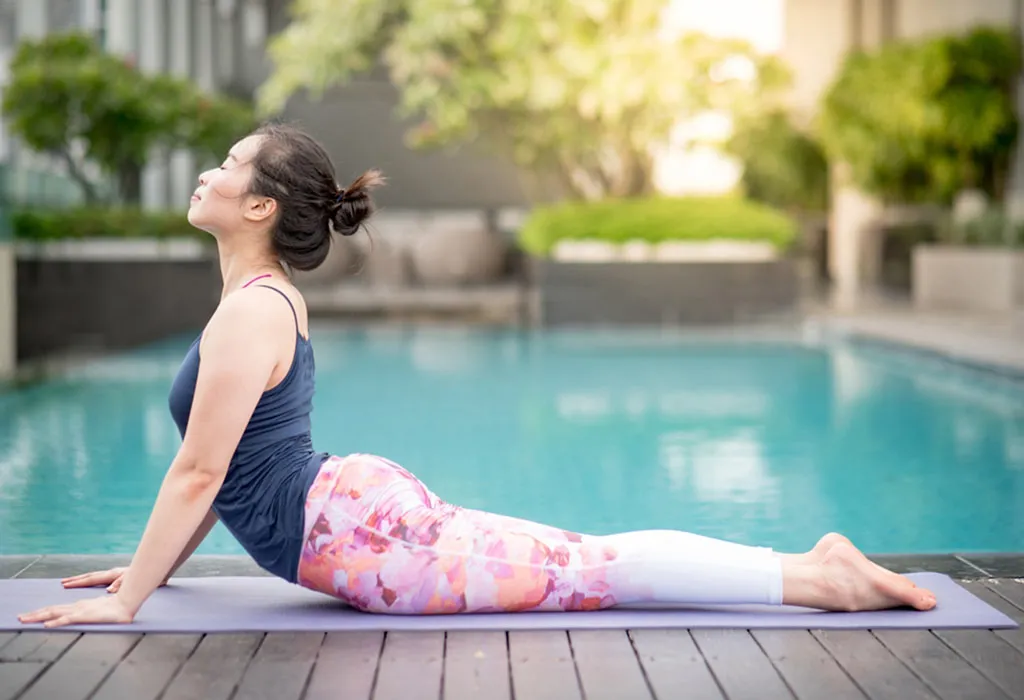
10. Camel Pose
The camel pose is the best yoga after delivery to reduce the weight around the tummy, along with strengthening all the major muscles of the body.
Benefits:
The excess belly fat left over after delivery is a source of discontent amongst many new mothers.
How to Perform:
Kneel on the yoga mat, keeping your spine upright and knees below the hips. Slowly tilt backwards while inhaling, touching your feet with your palms one after the other. Your shoulders, chest and arms should be stretched with a significant arch formed on the lower back. Hold this position for approximately 8 seconds while breathing normally. Repeat eight times per session.
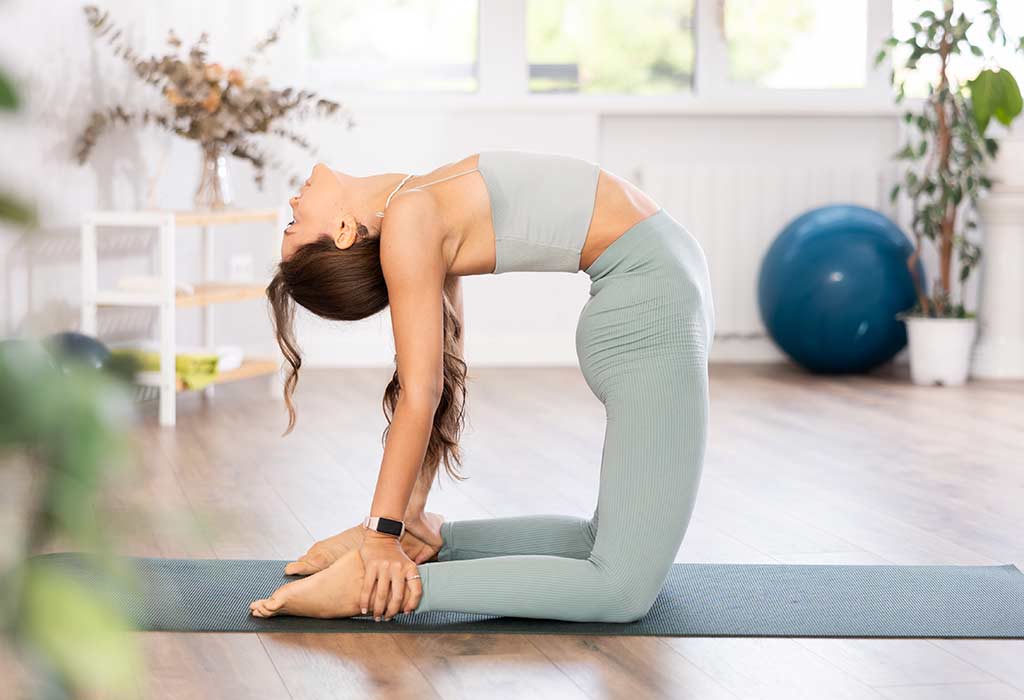
11. Scissors Pose
This move mimics the movement of a scissor in action and helps strengthen the abdomen.
Benefits:
It helps reduce belly fat and improve the flexibility of the hips and spine.
How to Perform:
Lie down on your back, keeping both legs and arms facing the ceiling. Move your left arm and leg upwards simultaneously as you move your right arm and legs downward. Reverse the motion and repeat five times.
12. Relaxation Pose
This pose can be done as a replacement for a power nap.
Benefits:
Helps relax after a workout while stretching the area around the hips and groin.
How to Perform:
Place a pillow lengthwise on the mat and lie down on it. With your head on the upper edge, close your eyes and breathe deeply and slowly. You should begin to feel relaxed very quickly.
13. Child’s Pose
Child’s Pose is a soothing and restorative position that provides gentle relief for the lower back and hips, making it an ideal choice for postpartum recovery.
Benefits:
Stretches the lower back, hips, and thighs, promoting relaxation.
How to Perform:
Kneel on the floor, sit back on your heels, and extend your arms forward on the mat. Rest your forehead on the ground and breathe deeply.
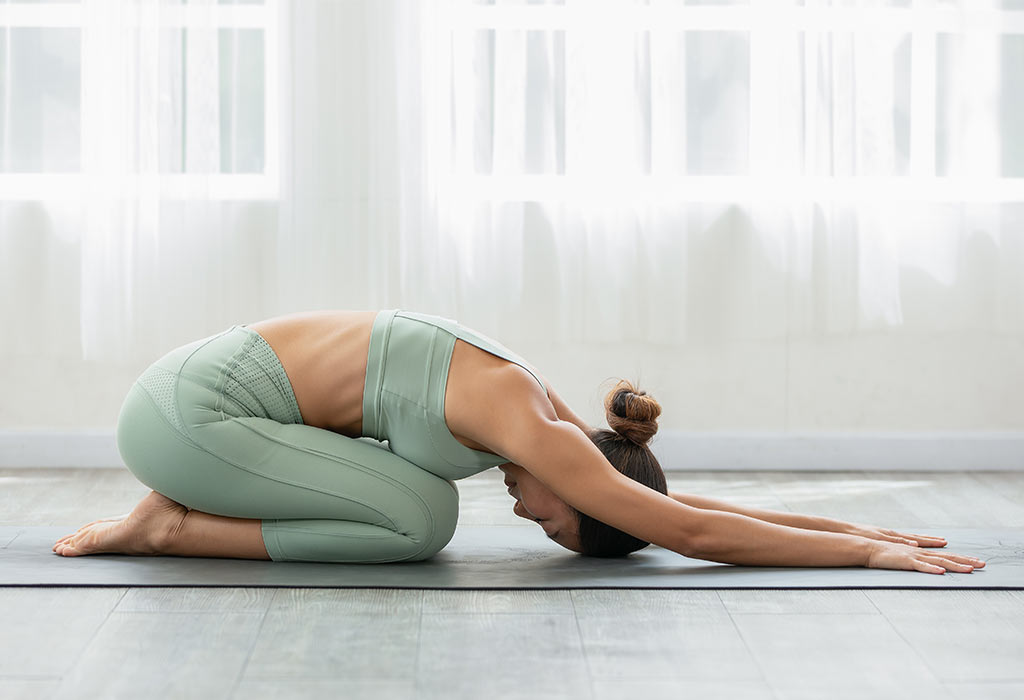
14. Cat-Cow Pose
Cat-Cow pose not only enhances spinal flexibility but also strengthens the core and back muscles
Benefits:
Enhances flexibility in the spine and strengthens the abdominal muscles.
How to Perform:
Start on all fours with your wrists directly under your shoulders and knees under your hips. Inhale, arch your back, and lift your head (Cow Pose). Exhale, round your spine, and tuck your chin (Cat Pose). Repeat for several breaths.
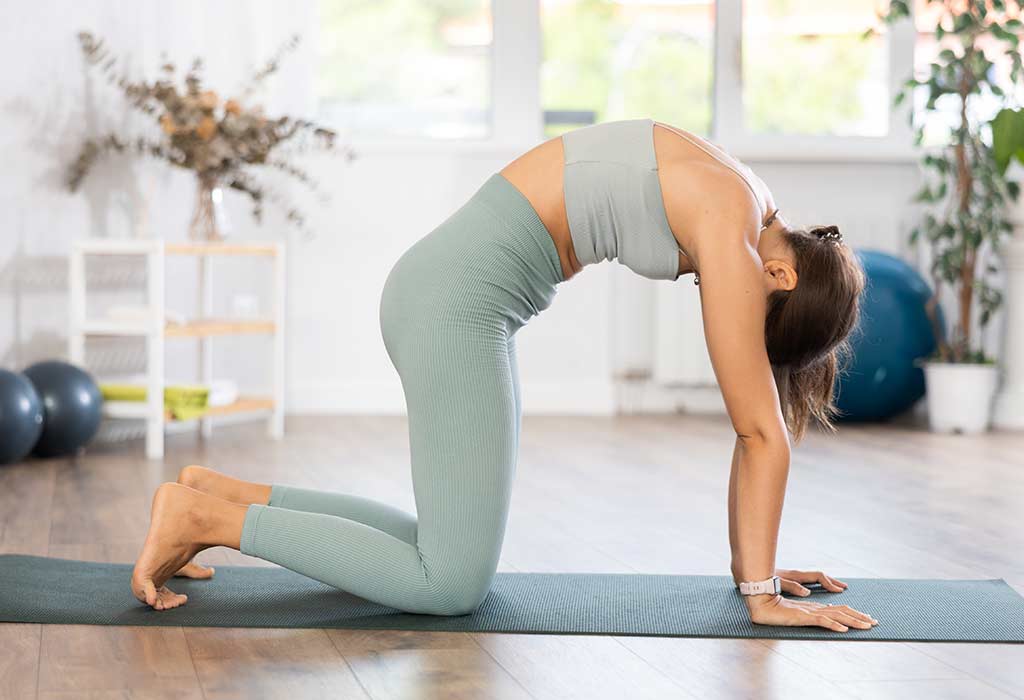
15. Legs-Up-The-Wall Pose
It is a calming pose that helps reduce swelling in the legs while promoting relaxation and rejuvenation for new mothers.
Benefits:
Reduces swelling in the legs and feet, promotes relaxation.
How to Perform:
Sit next to a wall and swing your legs up as you lower your back to the floor. Rest your legs against the wall, close your eyes, and breathe deeply.
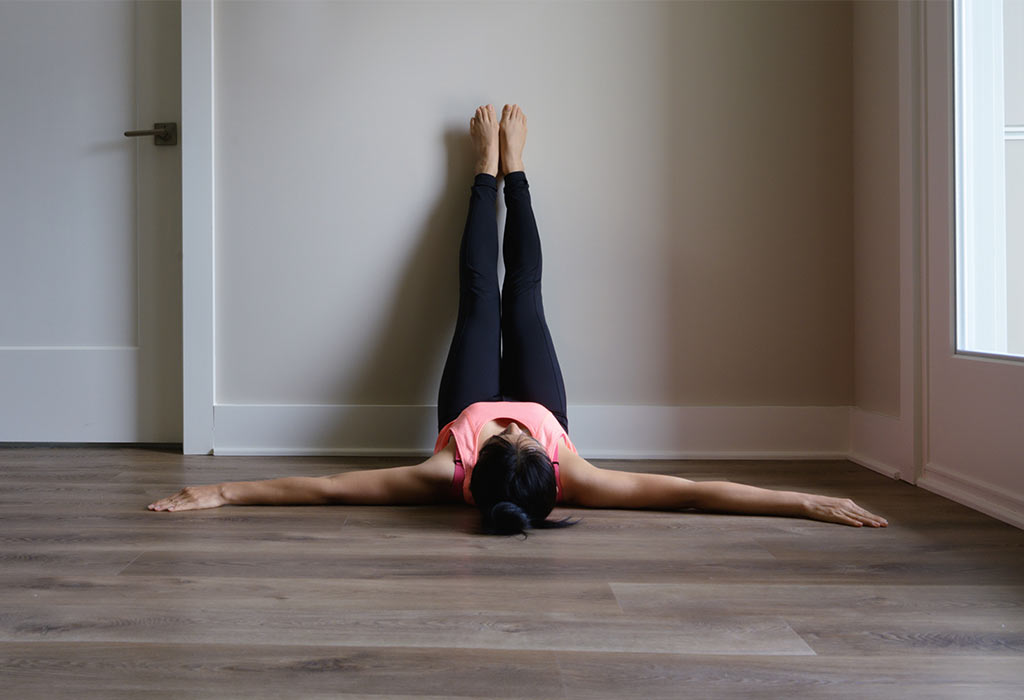
FAQs
1. How long should each session of postpartum yoga last?
Aim for 20-30 minutes per session, allowing time to warm up, practice poses, and cool down with relaxation techniques.
2. Can I practice yoga if I had a C-section?
Yes, but waiting until your doctor gives you the green light is essential. Focus on gentle poses and listen to your body throughout the practice (4).
3. Should I join a class or practice at home?
Both options have benefits. Joining a class can provide support and guidance, while practising at home offers flexibility and convenience. Choose what works best for you.
4. Are there specific poses I should avoid after delivery?
Yes, avoid intense abdominal exercises, deep twists, and poses that put excessive pressure on the pelvic floor until your body has healed adequately.
Yoga can help a woman’s post-pregnancy body closely resemble her pre-pregnancy form. However, the body should be given six months to recover from pregnancy before initiating yoga.
References/Resources:
1. Ranjan. P, Baboo. A. G. K, Anwar. W, et al.; Physical Activity, Yoga, and Exercise Prescription for Postpartum and Midlife Weight Management: A Practical Review for Clinicians; PubMed Central; https://www.ncbi.nlm.nih.gov/pmc/articles/PMC9008094/
2. Munns. L, Spark. N, Crossland. A, Preston. C; The effects of yoga-based interventions on postnatal mental health and well-being: A systematic review; PubMed Central; https://www.ncbi.nlm.nih.gov/pmc/articles/PMC10845905/
3. Yoga benefits beyond the mat; Harvard Health Publishing; https://www.health.harvard.edu/staying-healthy/yoga-benefits-beyond-the-mat
4. When and how to exercise after a c-section; Tommy’s; https://www.tommys.org/pregnancy-information/giving-birth/caesarean-section/when-and-how-exercise-after-c-section#
5. Anggraeni. N. P. D. A, Herawati. L, Widyawati. M. N; THE EFFECTIVENESS OF POSTPARTUM YOGA ON UTERINE INVOLUTION AMONG POSTPARTUM WOMEN IN INDONESIA; International Journal of Nursing and Health Services; https://ijnhs.net/index.php/ijnhs/article/view/164
Also Read:
Practising Yoga After C- Section
How to Lose Weight After C-Section Birth
How to Reduce Post Pregnancy Belly Fat
Fun Exercises Mother Can Do with Baby
Postpartum Stomach Exercises to Reduce Tummy After Delivery
Was This Article Helpful?
Parenting is a huge responsibility, for you as a caregiver, but also for us as a parenting content platform. We understand that and take our responsibility of creating credible content seriously. FirstCry Parenting articles are written and published only after extensive research using factually sound references to deliver quality content that is accurate, validated by experts, and completely reliable. To understand how we go about creating content that is credible, read our editorial policy here.







